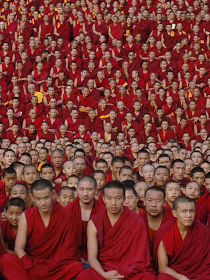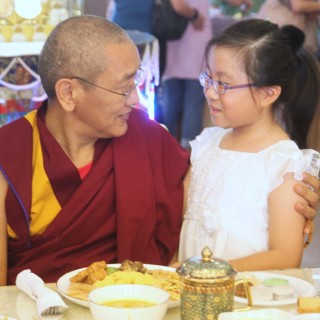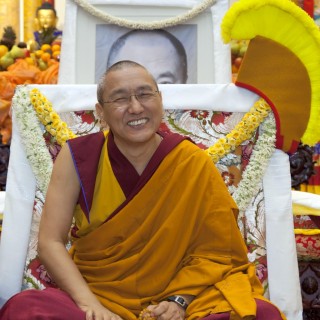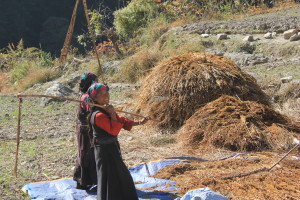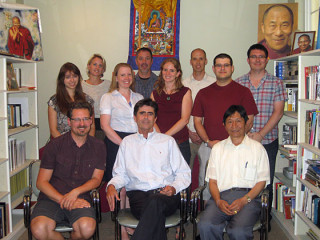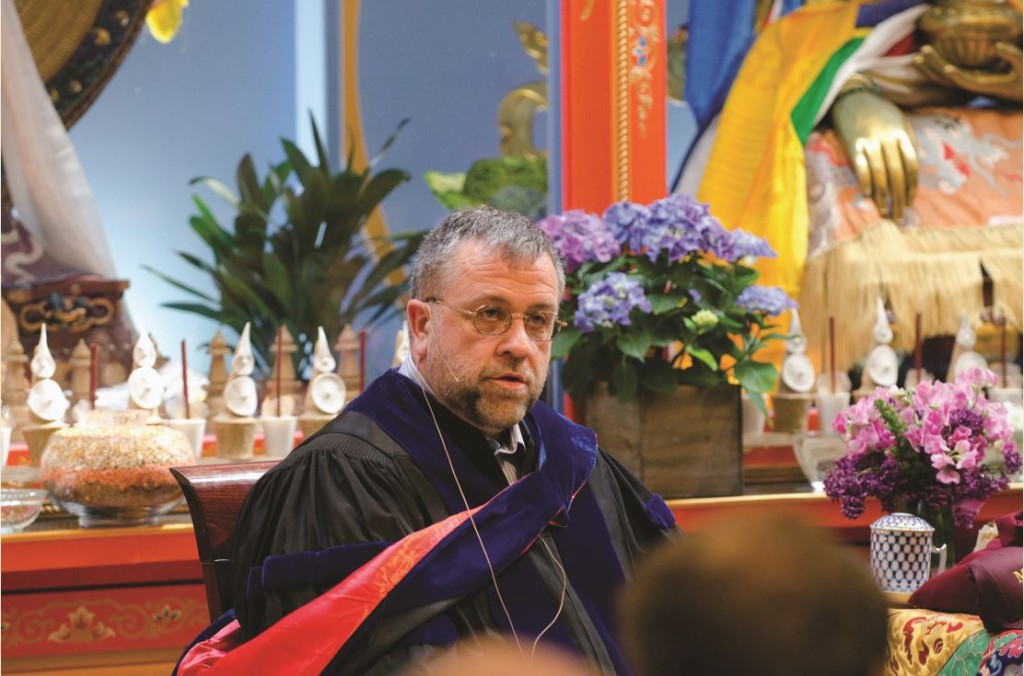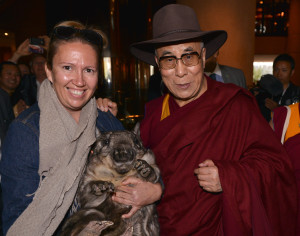- Home
- FPMT Homepage
Foundation for the Preservation of the Mahayana Tradition
The FPMT is an organization devoted to preserving and spreading Mahayana Buddhism worldwide by creating opportunities to listen, reflect, meditate, practice and actualize the unmistaken teachings of the Buddha and based on that experience spreading the Dharma to sentient beings. We provide integrated education through which people’s minds and hearts can be transformed into their highest potential for the benefit of others, inspired by an attitude of universal responsibility and service. We are committed to creating harmonious environments and helping all beings develop their full potential of infinite wisdom and compassion. Our organization is based on the Buddhist tradition of Lama Tsongkhapa of Tibet as taught to us by our founders Lama Thubten Yeshe and Lama Thubten Zopa Rinpoche.
- Willkommen
Die Stiftung zur Erhaltung der Mahayana Tradition (FPMT) ist eine Organisation, die sich weltweit für die Erhaltung und Verbreitung des Mahayana-Buddhismus einsetzt, indem sie Möglichkeiten schafft, den makellosen Lehren des Buddha zuzuhören, über sie zur reflektieren und zu meditieren und auf der Grundlage dieser Erfahrung das Dharma unter den Lebewesen zu verbreiten.
Wir bieten integrierte Schulungswege an, durch denen der Geist und das Herz der Menschen in ihr höchstes Potential verwandelt werden zum Wohl der anderen – inspiriert durch eine Haltung der universellen Verantwortung und dem Wunsch zu dienen. Wir haben uns verpflichtet, harmonische Umgebungen zu schaffen und allen Wesen zu helfen, ihr volles Potenzial unendlicher Weisheit und grenzenlosen Mitgefühls zu verwirklichen.
Unsere Organisation basiert auf der buddhistischen Tradition von Lama Tsongkhapa von Tibet, so wie sie uns von unseren Gründern Lama Thubten Yeshe und Lama Thubten Zopa Rinpoche gelehrt wird.
- Bienvenidos
La Fundación para la preservación de la tradición Mahayana (FPMT) es una organización que se dedica a preservar y difundir el budismo Mahayana en todo el mundo, creando oportunidades para escuchar, reflexionar, meditar, practicar y actualizar las enseñanzas inconfundibles de Buda y en base a esa experiencia difundir el Dharma a los seres.
Proporcionamos una educación integrada a través de la cual las mentes y los corazones de las personas se pueden transformar en su mayor potencial para el beneficio de los demás, inspirados por una actitud de responsabilidad y servicio universales. Estamos comprometidos a crear ambientes armoniosos y ayudar a todos los seres a desarrollar todo su potencial de infinita sabiduría y compasión.
Nuestra organización se basa en la tradición budista de Lama Tsongkhapa del Tíbet como nos lo enseñaron nuestros fundadores Lama Thubten Yeshe y Lama Zopa Rinpoche.
A continuación puede ver una lista de los centros y sus páginas web en su lengua preferida.
- Bienvenue
L’organisation de la FPMT a pour vocation la préservation et la diffusion du bouddhisme du mahayana dans le monde entier. Elle offre l’opportunité d’écouter, de réfléchir, de méditer, de pratiquer et de réaliser les enseignements excellents du Bouddha, pour ensuite transmettre le Dharma à tous les êtres. Nous proposons une formation intégrée grâce à laquelle le cœur et l’esprit de chacun peuvent accomplir leur potentiel le plus élevé pour le bien d’autrui, inspirés par le sens du service et une responsabilité universelle. Nous nous engageons à créer un environnement harmonieux et à aider tous les êtres à épanouir leur potentiel illimité de compassion et de sagesse. Notre organisation s’appuie sur la tradition guéloukpa de Lama Tsongkhapa du Tibet, telle qu’elle a été enseignée par nos fondateurs Lama Thoubtèn Yéshé et Lama Zopa Rinpoché.
Visitez le site de notre Editions Mahayana pour les traductions, conseils et nouvelles du Bureau international en français.
Voici une liste de centres et de leurs sites dans votre langue préférée
- Benvenuto
L’FPMT è un organizzazione il cui scopo è preservare e diffondere il Buddhismo Mahayana nel mondo, creando occasioni di ascolto, riflessione, meditazione e pratica dei perfetti insegnamenti del Buddha, al fine di attualizzare e diffondere il Dharma fra tutti gli esseri senzienti.
Offriamo un’educazione integrata, che può trasformare la mente e i cuori delle persone nel loro massimo potenziale, per il beneficio di tutti gli esseri, ispirati da un’attitudine di responsabilità universale e di servizio.
Il nostro obiettivo è quello di creare contesti armoniosi e aiutare tutti gli esseri a sviluppare in modo completo le proprie potenzialità di infinita saggezza e compassione.
La nostra organizzazione si basa sulla tradizione buddhista di Lama Tsongkhapa del Tibet, così come ci è stata insegnata dai nostri fondatori Lama Thubten Yeshe e Lama Zopa Rinpoche.
Di seguito potete trovare un elenco dei centri e dei loro siti nella lingua da voi prescelta.
- 欢迎 / 歡迎
简体中文
“护持大乘法脉基金会”( 英文简称:FPMT。全名:Foundation for the Preservation of the Mahayana Tradition) 是一个致力于护持和弘扬大乘佛法的国际佛教组织。我们提供听闻,思维,禅修,修行和实证佛陀无误教法的机会,以便让一切众生都能够享受佛法的指引和滋润。
我们全力创造和谐融洽的环境, 为人们提供解行并重的完整佛法教育,以便启发内在的环宇悲心及责任心,并开发内心所蕴藏的巨大潜能 — 无限的智慧与悲心 — 以便利益和服务一切有情。
FPMT的创办人是图腾耶喜喇嘛和喇嘛梭巴仁波切。我们所修习的是由两位上师所教导的,西藏喀巴大师的佛法传承。
繁體中文
護持大乘法脈基金會”( 英文簡稱:FPMT。全名:Found
ation for the Preservation of the Mahayana Tradition ) 是一個致力於護持和弘揚大乘佛法的國際佛教組織。我們提供聽聞, 思維,禪修,修行和實證佛陀無誤教法的機會,以便讓一切眾生都能 夠享受佛法的指引和滋潤。 我們全力創造和諧融洽的環境,
為人們提供解行並重的完整佛法教育,以便啟發內在的環宇悲心及責 任心,並開發內心所蘊藏的巨大潛能 — 無限的智慧與悲心 – – 以便利益和服務一切有情。 FPMT的創辦人是圖騰耶喜喇嘛和喇嘛梭巴仁波切。
我們所修習的是由兩位上師所教導的,西藏喀巴大師的佛法傳承。 察看道场信息:
- FPMT Homepage
- News/Media
-
- Study & Practice
-
-
- About FPMT Education Services
- Latest News
- Programs
- New to Buddhism?
- Buddhist Mind Science: Activating Your Potential
- Heart Advice for Death and Dying
- Discovering Buddhism
- Living in the Path
- Exploring Buddhism
- FPMT Basic Program
- FPMT Masters Program
- FPMT In-Depth Meditation Training
- Maitripa College
- Lotsawa Rinchen Zangpo Translator Program
- Universal Education for Compassion & Wisdom
- Online Learning Center
-
- Prayers & Practice Materials
- Overview of Prayers & Practices
- Full Catalogue of Prayers & Practice Materials
- Explore Popular Topics
- Benefiting Animals
- Chenrezig Resources
- Death & Dying Resources
- Lama Chopa (Guru Puja)
- Lama Zopa Rinpoche: Compendium of Precious Instructions
- Lama Zopa Rinpoche: Life Practice Advice
- Lama Zopa Rinpoche Practice Series
- Lamrim Resources
- Mantras
- Prayer Book Updates
- Purification Practices
- Sutras
- Thought Transformation (Lojong)
- Audio Materials
- Dharma Dates - Tibetan Calendar
- Translation Services
- Publishing Services
- Ways to Offer Support
- Prayers & Practice Materials
-
- Teachings and Advice
- Find Teachings and Advice
- Lama Zopa Rinpoche Advice Page
- Lama Zopa Rinpoche: Compendium of Precious Instructions
- Lama Zopa Rinpoche Video Teachings
- ༧སྐྱབས་རྗེ་བཟོད་པ་རིན་པོ་ཆེ་མཆོག་ནས་སྩལ་བའི་བཀའ་སློབ་བརྙན་འཕྲིན།
- Podcasts
- Lama Yeshe Wisdom Archive
- Buddhism FAQ
- Dharma for Young People
- Resources on Holy Objects
- Teachings and Advice
-
-
*If a menu item has a submenu clicking once will expand the menu clicking twice will open the page.
-
-
- Centers
-
- Teachers
-
- Projects
-
-
-
-
*If a menu item has a submenu clicking once will expand the menu clicking twice will open the page.
-
-
- FPMT
-
-
-
-
-
Realize that the nature of your mind is different from that of the flesh and bone of your physical body. Your mind is like a mirror, reflecting everything without discrimination. If you have understanding-wisdom, you can control the kind of reflection that you allow into the mirror of your mind.
Lama Thubten Yeshe
-
-
-
- Shop
-
-
-
The Foundation Store is FPMT’s online shop and features a vast selection of Buddhist study and practice materials written or recommended by our lineage gurus. These items include homestudy programs, prayers and practices in PDF or eBook format, materials for children, and other resources to support practitioners.
Items displayed in the shop are made available for Dharma practice and educational purposes, and never for the purpose of profiting from their sale. Please read FPMT Foundation Store Policy Regarding Dharma Items for more information.
-
-
Mandala
2
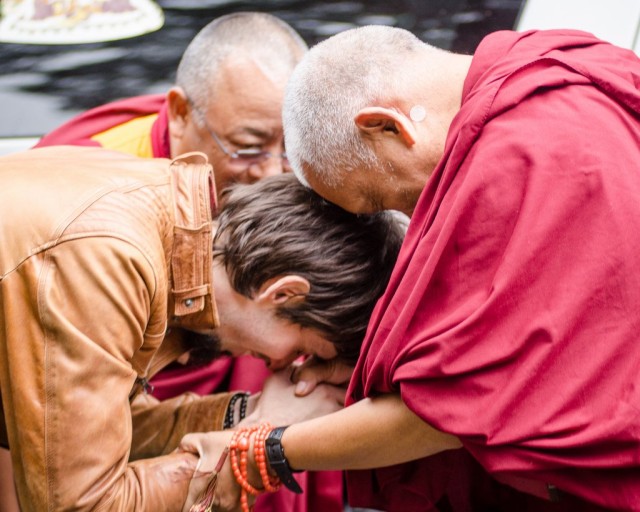
Tenzin Ösel Hita greeting Lama Zopa Rinpoche with Ven. Pemba Sherpa in the background, Land of Medicine Buddha, California, September 21, 2013. Photo by Chris Majors.
By Tenzin Ösel Hita
Read to FPMT spiritual director Lama Zopa Rinpoche by Tenzin Ösel Hita, the recognized reincarnation of FPMT founder Lama Yeshe, during the long life puja for Lama Zopa Rinpoche at Land of Medicine Buddha, Soquel, California, USA, on September 29, 2013.
Dearest spiritual friend and guide, Kyabje Zopa Rinpoche, you are so precious to us in so many different aspects. From so many angles in life, do you benefit us constantly with no break, no rest, no sleep.
Dear Lama Zopa-la, we are so grateful for your presence in this planet. We are so lucky to be able to share this space and time with you.
Since the beginning, you have dedicated your life fully to improving peoples’ spiritual lives, even though I’m sure you would love to spend many years in a Lawudo cave deep in meditation. Thank you so much for choosing to stay with us and guide us towards our inner potential.
We know how each and every action you do is dedicated to helping sentient beings – every thought, every breath; every sip of water you take is dedicated to sentient beings. We are so lucky to have you in our midst. You inspire us to be better people, and your presence gives us motivation to follow your example. You are constantly helping so many sentient beings from so many different dimensions. It is amazing to see your work in this world.
Please stay with us for as long as it takes all sentient beings to reach enlightenment. We are willing to follow your advice and work hard to accomplish your dreams, which, of course, are always focused on benefiting in the greatest way, in this life and the next.
We all thank you so much from the depth of our hearts; we wish you success in all of your vast visions present and future.
Lama Zopa-la please live a long life. And rest a bit when you can.
Thank you for guiding us relentlessly – without rest, without tiring.
Thank you for helping us purify, for sparking interest into investigating our own egos and ignorance.
Thank you for making us see how mistaken we are.
Please continue helping sentient beings, and live a long life, with no obstacles.
Thank you, Rinpoche, for your kindness and dedication.
We love you Lama Zopa-la.
Thank you so much.
—
Video of Tenzin Ösel Offering Praise to Lama Zopa Rinpoche
The long life puja for Lama Zopa Rinpoche was offered by FPMT Inc. Board of Directors and FPMT North America with logistical support from local FPMT centers and projects. The long life puja included the dance of the five dakinis in accordance with advice given by Khadro-la (Rangjung Neljorma Khadro Namsel Drönme) for Lama Zopa Rinpoche’s health and long life.
Photos from Lama Zopa Rinpoche’s visit to Land of Medicine Buddha can be found on photographer Chris Majors’ Flickr page.
Mandala brings you news of Lama Zopa Rinpoche and of activities, teachings and events from over 160 FPMT centers, projects and services around the globe. If you have news you would like to share, please let us know.
- Tagged: lama zopa rinpoche, land of medicine buddha, long life puja, mandala, praise for lama zopa rinpoche, tenzin osel hita
- 0

New prayer wheels from Nepal installed at the Garden of Enlightenment, Chenrezig Institute, Queensland, Australia, 2013. Photo by Ray Furminger.
From Garrey Foulkes
At the Garden of Enlightenment, a project of Chenrezig Institute in Queensland, all of the spaces for prayer wheels along the front wall of the main shrine building are now taken. The main building of the stupa garden serves as the base for eight great stupas, the largest of which is 10 meters (33 feet) tall. The shrine and stupas are surrounded by ornamental gardens. The prayer wheels along the front wall are colored wheels and were made at the Chenrezig art studio. They are very difficult to construct and expensive to produce. So on a recent trip to Kopan Monastery in Nepal, we looked at copper and brass wheels and decided to use the Nepali wheels for the remaining walls. They are far more practical, will last longer and, because of their slightly smaller size, we can fit many more prayer wheels along the walls. We received the first shipment of ten in April and already six have been sponsored.
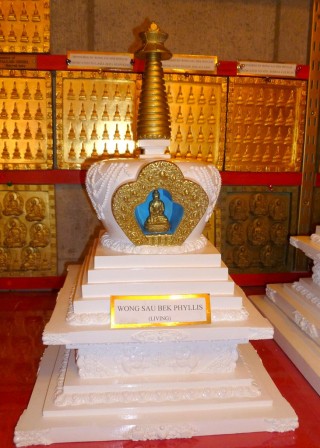
Stupa and wall of tsa-tsa tiles in shrine at Garden of Enlightenment, Queensland. Photo by Ray Furminger.
One very positive thing that has happened over the past three or four years is we are getting regular visits from schools to Chenrezig Institute and the Garden of Enlightenment. Often the students are coming from Christian colleges, when they are doing assignments on different religions. When they visit the gardens, we usually split into a few groups and senior students talk them through the project and encourage general questions. The result always seems to be positive as most of the questions are well thought through, often brilliant and sometimes hilarious.
We continue to offer half of the money donated for tsa-tsa tiles on the internal walls of the shrine building to the Maitreya Project. Small memorial stupas are also located inside the building as well as being placed throughout the gardens.
Mandala brings you news and updates from over 160 FPMT centers, projects and services around the globe. If you have a story to share, please let us know.
26
Messina “City of Compassion”
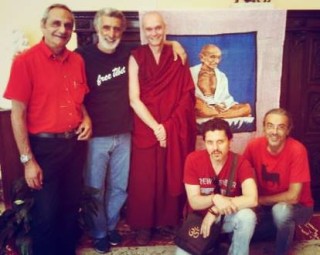
Study group members with Messina Mayor Renato Accorinti (in Free Tibet t-shirt). Photo courtesy of Shakyamuni Study Group.
“What’s happening in Messina these days has been amazing,” wrote Guglielmo Margio coordinator of Shakyamuni Study Group in Messina, Sicily.
The study group organized a retreat on lo-jong, attended by more than 20 people. The group has also arranged meetings with the new mayor of Messina, Renato Accorinti, who has met His Holiness the Dalai Lama on several occasions in recent years. During these meetings, they have discussed making the city of Messina officially the “city of compassion,” which they believe would positively influence many initiatives in the future. The new mayor intends to invite His Holiness to come to Messina, Guglielmo reported, and there is hope to make His Holiness an honorary citizen of the city.
“[We’re] happy and proud for the work done,” Guglielmo wrote. “It’s the beginning of a great, great adventure for the benefit of all sentient beings. … Each of us needs, especially at this particular time of economic and social crisis, to develop a calm mind and a good heart and to cultivate hope.”
Mandala brings you news of Lama Zopa Rinpoche and of activities, teachings and events from over 160 FPMT centers, projects and services around the globe. If you have news you would like to share, please let us know.
- Tagged: mandala, shakyamuni study group
- 0
25
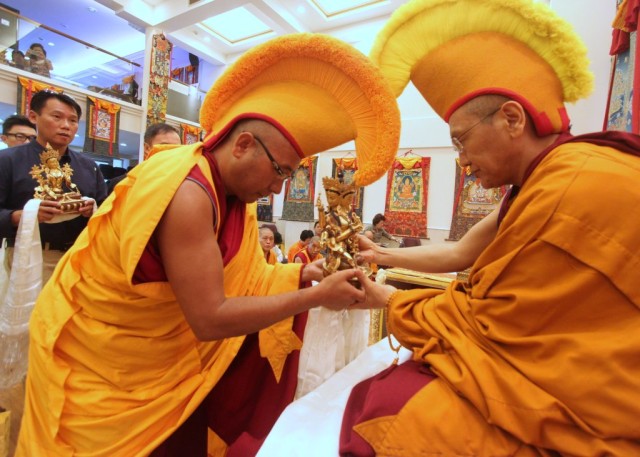
Khen Rinpoche Geshe Chonyi receiving offering from Geshe Sherab at long life puja, Amitabha Buddhist Centre, Singapore, July 2013. All photos by Tan Seow Kheng; courtesy of ABC.
By Ven. Tenzin Tsultrim
In July 2013, Khen Rinpoche Geshe Chonyi accepted his first long life puja in the presence of some 200 students and well-wishers at Amitabha Buddhist Centre (ABC) in Singapore. Khen Rinpoche, who is ABC’s resident teacher as well as the abbot of Kopan Monastery and Nunnery, said he enjoyed receiving the puja, which was organized to celebrate his 51st birthday.
For 10 years, Khen Rinpoche joked, he was used to being the one making the offerings during the long life ceremonies for Lama Zopa Rinpoche and Khensur Rinpoche Lama Lhundrup. This time, the ritual master was Geshe Thubten Sherab, who had accepted the invitation to travel from Kopan Monastery for the occasion. The puja itself was led by the chanting master of Kopan Monastery, Geshe Lobsang Sherab. The resident teachers and directors of the three FPMT centers in Malaysia also made a special trip to Singapore to be part of the celebration.
Khen Rinpoche spoke before the puja on how to make the practice meaningful:
We all know what Lama Zopa Rinpoche has mentioned before about the long life puja. Mainly when we offer long life puja to the gurus, we have a Dharma connection with them. From your heart, when you make strong requests for the gurus to live long, that helps the guru to live long. The whole point why you are requesting is because you see some benefit for the guru to live long. If you can see from your heart why the guru needs to live long, then make single-pointed request to the gurus. When you request the guru to live long, at the same time you yourself have long life. That is the benefit. Both of you [guru and disciple] get the benefit.
When you do the long life puja, it is mainly the practice of Guru Puja. Remember to visualize or think that your own guru is in front of you. It doesn’t have to be me. Those who have a close Dharma connection with your own gurus, you can visualize them. Then you make these extensive offerings to the guru from your heart, and make strong requests for the guru to live long.
Make sure, as you are doing the Guru Puja, to make it meaningful for yourself. When you do it well, that means you are closer to the gurus. That means you are closer to enlightenment, closer to the Buddha, closer to the Dharma, closer to the Sangha. Make sure you do that. I think it is extremely important.
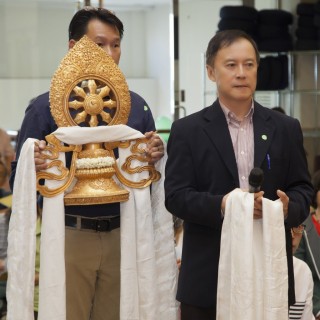
ABC vice-president Fred Cheong and director Tan Hup Cheng presenting Dharma wheel, Singapore, July 2013
Among the procession of offerings presented to Khen Rinpoche was an impressively large Dharma wheel, a gift from the center and the second batch of Basic Program students whom Khen Rinpoche has taught for the past two years. Representing the center and the students, ABC’s director Tan Hup Cheng and vice-president Fred Cheong presented the gigantic wheel to Khen Rinpoche together with a strong request that he would continue to teach at ABC for a very long time.
Besides the Basic Program, Khen Rinpoche teaches a weekly lam-rim class that is translated for Chinese speakers, and a monthly “Dharma for Seniors” class. Khen Rinpoche has also formed a bond with some of the youngest members of ABC, including ten-year-old Melody Wee, who offered a song. Her mature and captivating rendition of “If We Hold on Together” held all the grown-ups in misty-eyed rapture.
At the end of the puja, Khen Rinpoche offered an insight into his life and why he has continued to stay as ABC’s resident teacher:
I was born in 1962. I spent 12 years with my family. After that I spent six years in Kopan Monastery, then I spent another 18 to 19 years in South India, then I spent 14 years in Singapore.
When I look back at myself, how I became a monk is because I met Lama Yeshe, the first time when I was aged 12, in 1974. Lama Yeshe came all the way to my hometown and I met him there. Because of that I was able to become a monk, to be ordained. After I became ordained I spent six years at Kopan. I was able to stay as a monk because of the late ex-abbot Lama Lhundrup. When I was 15 to 17 years old, my mind was always wandering. It was not an easy time, under different conditions. Because of his advice, I was able to remain as a monk at that time. After that I moved to South India. I had all this education [at Sera Je Monastery]. All this depended one hundred per cent on my teacher [Khensur Rinpoche Lobsang Tsering, ex-abbot of Sera Je Monastery]. Because of his kindness, I was able to complete my studies at the level of geshe. After that, I came to Singapore.
Being able to live here for 14 years is all from depending on Lama Zopa Rinpoche’s advice. I mentioned before, when I came for the first time to Singapore, I thought I would stay just one year. I told my friends, everybody, I would try for one year. After one year I will be back, I said! Somehow I have stayed until now, because of Rinpoche’s advice.
Why I have stayed here so long is because of the members and students of Amitabha Buddhist Centre, because they all have some interest to learn Buddhadharma. That is the main thing that has made me stay here, so far, because I see that people have interest, put in effort. Some of them really, for 14 years they are here with me, without missing class, twice a week. When I see their lives, how busy they are. They have to work from morning to night. Also, they have families, have to go out with the family, need time for the family, but still they put in so much effort and come to class. So really, that really makes me stay in Singapore, here, to teach. That is the main reason. How long I stay here all depends on that. Entirely depends on that.
In keeping with the occasion of celebrating Khen Rinpoche’s birthday, there was a festive mood to the puja. And true to Singapore’s culture, the celebration was made complete with hearty eating, a Thai-style lunch buffet treat for everyone from ABC’s Executive Committee, who requested Khen Rinpoche to accept the long life puja and who also organized it.
Mandala brings you news of Lama Zopa Rinpoche and of activities, teachings and events from over 160 FPMT centers, projects and services around the globe. If you have news you would like to share, please let us know.
24
A Spiritual Journey to Tsum
In 2012, Canadian travel writer Jane Marshall visited Nepal’s remote Tsum Valley while researching a book about Kushok Lobsang Dhamchöe, a Tibetan Buddhist monk originally from Tsum and now living in Edmonton. “It’s a place etched permanently in my memory,” Jane wrote about her journey. She shared an account of her travels in the online edition of Mandala October-December 2013:
“After the last navigable road, the path begins; it rises and falls along the steep sides of the Budhi Gandaki ravine before breaking east toward the Tibet border. Elevations range from around 500-4,500 meters [1,600-14,800 feet] and the religion transforms from Hinduism to Buddhism,” Jane wrote.
“Tsum Valley only opened to travel in 2008 (though a handful of intrepid researchers and travelers were given restricted access prior). Once part of Tibet, it was swallowed into Nepal and thus escaped the devastation of Chinese occupation. Ancient Buddhist traditions were preserved and, within this protection, I searched for links to Kushok’s past. His birth village is only a day’s hike from Tsum.
“Rhesus monkeys danced in the trees; I pressed my body into a cliff wall as another mule train descended. The spires and peaks of Shringi and Ganesh Himal danced like goddesses on the blue sky.
“At the top of yet another ridge, after slogging amongst marijuana bushes and stinging nettles, through puddles of donkey urine and over unstable rock, I’d think, ‘Yes! I’ve made it! That wasn’t so hard.’ Then I’d see four more rises and my ego would crack. My bones groaned, my emotions balked, and my mind would form a mini hell for awhile.” …
From Mandala October-December 2013
23
‘I Realized That My Life Couldn’t Be the Same Again’
Australian nun Ven. Margaret McAndrew arrived at Kopan in 1974, and like many long-time students of Lama Yeshe and Lama Zopa Rinpoche who attended the Kopan Courses, she saw her life changed profoundly. Mandala has been collecting these stories in our ongoing “Road to Kopan” series. Here Ani Margaret shares her experience of first meeting the Dharma in the October-December 2013 “Road to Kopan.”
When I think back to my first days with the Lamas and the Dharma, it is strange to look at how much has happened since. We were a group of eager, enthusiastic people, mostly quite young (although I was relatively old at 30). In those days, there were a lot of young people from many countries drifting round Asia on the cheap, mostly influenced to some degree by the hippie movement. But you didn’t say they were “hippies” – you had to call them “freaks.” When anything interesting was happening in that part of the world, the news would spread like wildfire through the travelers’ network, and one of the big items of interest was “the Kopan courses” and “the Lamas.”
… Even when the Lamas weren’t there, Kopan was a fascinating place, with the lively young monks running around supervised by a very special being, Lama Lhundrup, and by the impressive Lama Pasang, against a colorful background of the Nepalese countryside and its traditional people. The contingent of Westerners included a number of charismatic personalities, such as Anila Ann McNeil, who led my first meditation course. The only dark note was our discovery about Lama’s bad health. Again and again, Western doctors gave him only six months to live, but somehow he kept on going, staying with us for 10 years from the first time I met him.
… There was no doubt that the Lamas knew our minds and could respond to our prayers and unspoken thoughts. In the early days at Chenrezig Institute [in Australia], when the Lamas were visiting, I very much wanted to have a one-to-one meeting with Lama Yeshe, but didn’t feel entitled to request one. Instead, I prayed to Lama to make it happen if that would be good. One day, in a big sunhat, he just popped up out of the long grass that grew all over the hill in those days, where he had been sitting waiting. We had quite a good talk before the inevitable group of students started to gather. …
From Mandala October-December 2013
It’s a big week for Wisdom Publications, a leading publisher of Buddhist books and an affiliate of FPMT. The Somerville, Massachusetts-based publisher announced a new website with a new blog as well as a new distribution arrangement with the international publisher Simon and Schuster.
“We look forward to working with Simon and Schuster to better fulfill our mission of nurturing communities of readers and authors by being a source of high quality, polished and carefully chosen works,” said Tim McNeill, Wisdom Publications CEO.
While Wisdom publishes books from all major Buddhist traditions, the publisher’s catalog of Tibetan Buddhist titles is unparalleled and includes the exceptional Library of Tibetan Classics series as well as titles by many 20th-century Tibetan Buddhist masters.
Wisdom origins stretch back to Lama Yeshe and Lama Zopa Rinpoche’s early days of teaching Dharma to Westerns at Kopan Monastery in Nepal. Ven. Robina Courtina and Lama Yeshe Wisdom Archive director Nick Ribush were involved in the early development of Wisdom Publications. Tim McNeill, a long-time FPMT student and current member of the FPMT Inc. Board of Directors, has led Wisdom and its impressive staff for the past 25 years.
If you like what you read on Mandala, consider becoming a Friend of FPMT, which supports our work.
- Tagged: tim mcneill, wisdom publications
- 0
20

Image: Dreamstime
In the print edition of Mandala October-December 2013, we spoke with Alan Carter, who served as resident teacher at Chandrakirti Centre in New Zealand and now works as a life coach, about how self-acceptance is key to a successful Dharma practice. We continue our interview with Alan here, talking about his background, a few more thoughts on self-acceptance, and how to bring Dharma into the community.
Mandala: You talked about how self-acceptance is the foundation of Dharma practice. And how accepting one’s self and accepting others are related. How can we work with this in our Dharma centers?
Alan: I think within centers it is important to have open discussions. I think it is important to get together and take the risk of people scrambling for words and saying, “Oh, I’m not quite sure, but this is how I feel,” and having that sense of acceptance by others as to where we are at. And that acceptance of others helps with accepting ourselves.
This is very much Carl Rogers’ person-centered therapy with the client: you accept that person. You don’t dislike or like any aspect of them, you just accept that individual, and through accepting that person for exactly where they are at, then that person learns to accept himself or herself. Within Dharma centers, this is an ideal opportunity for us to get together and talk about these issues in a very open way in an accepting environment. I think that process for acceptance would help within Buddhist centers.
… Mandala: Talk a bit more about your work bringing Dharma into the community. I know we all think about doing that. What does it look like for you in your work?
Alan: Since my retreat last year, I actually do more volunteer work within the community. At centers sometimes it seems that volunteer work is very much focused on doing work at the center. It is like, “OK, if you do things at the center, there is an enormous amount of merit because you are working for the guru and supporting part of Lama Zopa Rinpoche’s mandala,” which is very wonderful. But sometimes that feels like it creates distance from actually being out in the community and just being a nobody helping out, whereas at a center, we are more of a somebody than a nobody. As an example, I work in a hospice on a fortnightly basis for a couple of hours. I find the greatest experience is going in there and just doing whatever people need, which could be just talking to the patients. I switch off who I am in a way, and I find that really quite special. …
From Mandala October-December 2013
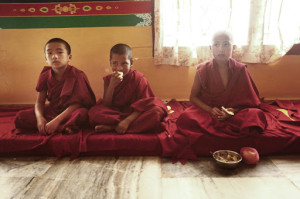
Young monks from Sera Je benefit from the meal provided by the Sera Je Food Fund. Photo courtesy https://photos.app.goo.gl/C4MnbETKrdyayPtU6
In Mandala October-December 2013, Geshe Thubten Jinpa writes about the benefits of the Sera Je Food Fund, an FPMT Charitable Project dedicated to offering three meals a day to the 2,500 monks of Sera Je Monastery.
A 78-year-old monk walks back and forth two times every day for the meal being served in the main prayer hall of Sera Je Monastic University, situated in South India. After each meal, he comes back with a half-loaf of bread that he did not finish. I thought the leftover bread would go in the garbage bin, but I was wrong. He puts the bread in the sun and lets it dry. Later in the day when his young disciples come back hungry from class, he offers the dry piece of bread as a snack with a cup of black tea.
This old monk has been doing this for decades. Now it is just a habit, but 30 years ago he started this ritual out of helplessness and responsibility. In those days, senior monks who had young disciples had to save half of their food so that their young pupils could eat and be able to continue their studies in the evening without an empty stomach.
… Today, the Sera Je Food Fund provides highly nutritious meals, hygienically prepared for thousands of monks every day. Since the food fund started in 1991, the health of all the monks improved dramatically. They are now able to devote their full time to their Dharma studies without worrying about their meals or if they will have enough food. The most significant impact of the Sera Je Food Fund can be seen by the increase of numbers of the monks, and that senior monks like Geshe Wangchen are now able to accept as many new students as they can without worry.
From Mandala October-December 2013
Currently, the Sera Je Food Fund offers over 3 million meals annually. You can learn more about the fund and make a contribution to the project online.
16
Cat Rescue as a Means to Creating Merit
Long-time student Amy Barton-Cayton shares how she used Lama Zopa Rinpoche’s advice to turn cat rescue into Buddhist practice as part of Mandala’s October-December 2013 online content:
In 2007, I had a huge karmic upheaval, mostly manifesting in my body. Among other things where karma had run out for me, I was no longer so able to travel through the FPMT world giving trainings as my form of service to Lama Zopa Rinpoche.
“Uh-oh,” I thought. I interpreted my situation to mean that following purification, I needed to create merit. How would I do this since many of my former avenues of merit-making were no longer open to me? Perhaps, as life was pointing to a less active way of “showing up,” I could spend more time meditating. The only problem was that mental focus was one of the many things that had suddenly shifted and become elusive.
… When I eventually saw Rinpoche, I suggested maybe it was OK for me now to see a few people in my role as therapist and then try to help some sentient being of the cat variety. Rinpoche gave me some advice about practices for really helping the kitties, and since then, cat cuddling according to Rinpoche’s instructions has been a huge part of my practice. …
From Mandala October-December 2013
12
The Sera Connection: An Interview with José Cabezón
José Cabezón is a respected professor of religious studies and the Fourteenth Dalai Lama Endowed Chair in Tibetan Buddhism and Cultural Studies at the University of California, Santa Barbara. He studied at Sera Monastic University in South India and completed his Ph.D., studying with Geshe Lhundub Sopa, at the University of Wisconsin. Mandala spoke with José during a visit to Portland, Oregon, in May 2013.
Mandala: Having experienced both monastery life in India and also non-monastic life in the United States, where do you see the intersection of Western culture and Buddhist culture going?
José: That is a very big question, and I think there is no single answer. It is more where our different traditions – or even within traditions – where our different organizations are heading. I think there are many different answers to that. Some traditions still emphasize relying on teachers that come from an Asian background. Other traditions are training their own Western teachers and are trying to make the move to create a Western Sangha that can kind of take over from the Asian teachers. I think it is too early to generalize from one tradition to another.
I’ll tell you a story. It is one of my favorites. When Lama Yeshe invited His Holiness to Spain for the first time [in 1982], I was translator for His Holiness. I never knew Lama Yeshe very well; but one day during this trip, Lama Yeshe invited me to have a meal with him. He asked me, “What do you think about the future of Buddhism in the West?” And I said, “I don’t know. My nature is somewhat pessimistic, so I don’t know. The West is so materialistic, and I don’t know whether authentic Buddhism will really be able to take a foothold.” Lama Yeshe said, “No, I think it will. Maybe not just in any place, but Spain is the place of the future.” So it struck me that then Tenzin Ösel Hita was recognized in Spain. I always took that as a kind of sign that Lama Yeshe saw something as being special about Spain. When I heard that his reincarnation had been recognized in a Spanish boy, I didn’t find it strange.
From Mandala October-December 2013
If you like what you read on Mandala, consider becoming a Friend of FPMT, which supports our work.
11
His Holiness the Dalai Lama Visits New Zealand and Australia
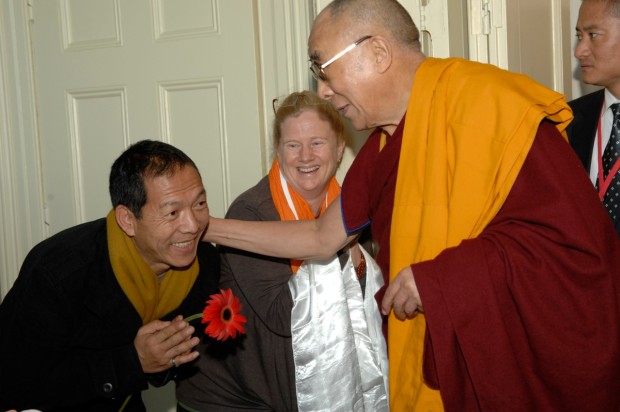
His Holiness the Dalai Lama recognizes and greeted Chandrakirti Meditation Centre translator Tenzin Thubwang, July 2013. Photo courtesy of Phillipa Rutherford.
In June 2013, His Holiness the Dalai Lama visited New Zealand before making his way to Australia for his ninth visit to the country. As part of the Mandala October-December 2013 online content, we offer three stories on the visit.
FPMT co-director of Chandrakirti Centre in Richmond, New Zealand, Phillipa Rutherford, shared with Mandala a short summary of the “very intimate” visit by His Holiness plus a couple of photos of His Holiness meeting with devoted students in Dunedin.
Sally Dudgeon, who was involved with His Holiness’ most recent visit to Australia, shared a report on the four-city tour themed “Beyond Religion, the 14th Dalai Lama on the Benefits of Living Ethically.” The organization Dalai Lama in Australia (DLIA) managed the tour as well as most of the previous tours by His Holiness’ to Australia. DLIA is a non-profit company formed in 2001 by George Farley and Alan Molloy, both students of Lama Zopa Rinpoche.
The June tour included a stop in Melbourne to teach the Heart Sutra and the Eight Verses of Mind Training at Quang Minh Temple, a Vietnamese Buddhist temple in the suburb of Braybrook. Cynthia Karena captured the perspective and feelings of some of the volunteers at the “happy and joyous” event.
If you like what you read on Mandala, consider becoming a Friend of FPMT, which supports our work.
- Home
- News/Media
- Study & Practice
- About FPMT Education Services
- Latest News
- Programs
- New to Buddhism?
- Buddhist Mind Science: Activating Your Potential
- Heart Advice for Death and Dying
- Discovering Buddhism
- Living in the Path
- Exploring Buddhism
- FPMT Basic Program
- FPMT Masters Program
- FPMT In-Depth Meditation Training
- Maitripa College
- Lotsawa Rinchen Zangpo Translator Program
- Universal Education for Compassion & Wisdom
- Online Learning Center
- Prayers & Practice Materials
- Overview of Prayers & Practices
- Full Catalogue of Prayers & Practice Materials
- Explore Popular Topics
- Benefiting Animals
- Chenrezig Resources
- Death & Dying Resources
- Lama Chopa (Guru Puja)
- Lama Zopa Rinpoche: Compendium of Precious Instructions
- Lama Zopa Rinpoche: Life Practice Advice
- Lama Zopa Rinpoche Practice Series
- Lamrim Resources
- Mantras
- Prayer Book Updates
- Purification Practices
- Sutras
- Thought Transformation (Lojong)
- Audio Materials
- Dharma Dates – Tibetan Calendar
- Translation Services
- Publishing Services
- Teachings and Advice
- Find Teachings and Advice
- Lama Zopa Rinpoche Advice Page
- Lama Zopa Rinpoche: Compendium of Precious Instructions
- Lama Zopa Rinpoche Video Teachings
- ༧སྐྱབས་རྗེ་བཟོད་པ་རིན་པོ་ཆེ་མཆོག་ནས་སྩལ་བའི་བཀའ་སློབ་བརྙན་འཕྲིན།
- Podcasts
- Lama Yeshe Wisdom Archive
- Buddhism FAQ
- Dharma for Young People
- Resources on Holy Objects
- Ways to Offer Support
- Centers
- Affiliates Area
- Teachers
- Projects
- Charitable Projects
- Make a Donation
- Applying for Grants
- News about Projects
- Other Projects within FPMT
- Support International Office
- Projects Photo Galleries
- Give Where Most Needed
- FPMT
- Shop
Subscribe to FPMT News
Translate*
*powered by Google TranslateTranslation of pages on fpmt.org is performed by Google Translate, a third party service which FPMT has no control over. The service provides automated computer translations that are only an approximation of the websites' original content. The translations should not be considered exact and only used as a rough guide.If you want to be loved, love others first.







